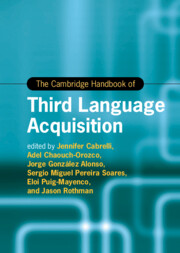Book contents
- The Cambridge Handbook of Third Language Acquisition
- Cambridge Handbooks in Language and Linguistics
- The Cambridge Handbook of Third Language Acquisition
- Copyright page
- Contents
- Figures
- Tables
- Contributors
- Introduction Multilingualism
- Part I Theoretical Approaches to L3/Ln
- Part II L3/Ln across Linguistic Domains
- Part III Becoming and Staying Multilingual at Different Ages
- 11 3L1 Acquisition
- 12 Multilingualism and Education
- 13 Language Attrition and L3/Ln
- 14 Heritage Speakers as L3 Acquirers
- 15 The Effects of Environment Change on Third Languages
- Part IV L3/Ln in Action
- Part V L3/Ln and Cognition
- Part VI Research Methods in L3/Ln
- Index
- References
11 - 3L1 Acquisition
Three First Languages during Early Childhood
from Part III - Becoming and Staying Multilingual at Different Ages
Published online by Cambridge University Press: 13 July 2023
- The Cambridge Handbook of Third Language Acquisition
- Cambridge Handbooks in Language and Linguistics
- The Cambridge Handbook of Third Language Acquisition
- Copyright page
- Contents
- Figures
- Tables
- Contributors
- Introduction Multilingualism
- Part I Theoretical Approaches to L3/Ln
- Part II L3/Ln across Linguistic Domains
- Part III Becoming and Staying Multilingual at Different Ages
- 11 3L1 Acquisition
- 12 Multilingualism and Education
- 13 Language Attrition and L3/Ln
- 14 Heritage Speakers as L3 Acquirers
- 15 The Effects of Environment Change on Third Languages
- Part IV L3/Ln in Action
- Part V L3/Ln and Cognition
- Part VI Research Methods in L3/Ln
- Index
- References
Summary
This chapter is concerned with 3L1 acquisition (early trilingualism; i.e., the development of three languages during early childhood). This is a methodologically challenging and understudied topic, most typically focussing on children with two home languages that are both different from the language of the wider community. The available research on lexicon, syntax, and phonology shows that trilinguals can develop three languages at once in essentially the same way as monolingual and bilingual children do, with language-specific patterns in each of them. However, the languages interact and the additional language (compared to bilingual acquisition) complicates this interaction. I discuss whether and how early trilingualism and early bilingualism differ, and what the roles of language experience and typological distance are. More than any other setting, early trilingualism shows that children can acquire complex linguistic properties with substantially reduced exposure from a very young age. However, maintenance of all three languages is an issue, which mirrors findings on bilingual (heritage) speakers.
- Type
- Chapter
- Information
- The Cambridge Handbook of Third Language Acquisition , pp. 271 - 294Publisher: Cambridge University PressPrint publication year: 2023



